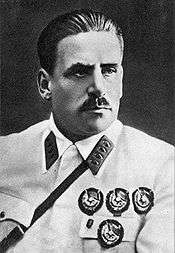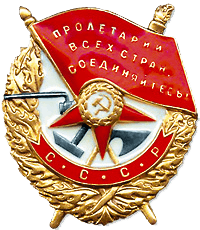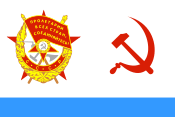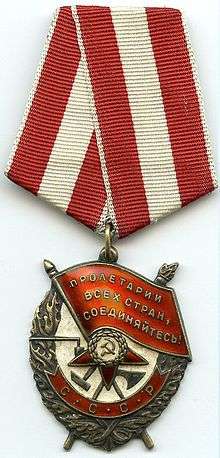Order of the Red Banner
| Order of the Red Banner | |
|---|---|
|
The Order of the Red Banner | |
|
Awarded by the | |
| Type | Single-grade order |
| Eligibility | Soviet Citizens |
| Awarded for | Heroism in combat or long service in the armed forces |
| Status | No longer awarded |
| Statistics | |
| Established | August 1, 1924 |
| Last awarded | 1991 |
| Total awarded | 581,300 |
| Precedence | |
| Next (higher) | Order of the October Revolution |
| Equivalent | Order of the Red Banner of Labour |
| Next (lower) | Order of Suvorov |
|
Ribbon of the Order of the Red Banner | |




The Order of the Red Banner (Russian: Орден Крaсного Знамени) was the first Soviet military decoration. The order was established on 16 September 1918, during the Russian Civil War by decree of the All-Russian Central Executive Committee. It was the highest award of Soviet Russia, subsequently the Soviet Union, until the Order of Lenin was established in 1930. Recipients were recognised for extraordinary heroism, dedication, and courage demonstrated on the battlefield. The order was awarded to individuals as well as to military units, cities, ships, political and social organizations, and state enterprises. In later years it was also awarded on the twentieth and again on the thirtieth anniversary of military service without requiring participation in combat.
Award history
The Russian Order of the Red Banner was established during the Russian Civil War by decree of the All-Russian Central Executive Committee of September 16, 1918.[1]
The first recipient was Vasily Blyukher[2] on September 28, 1918.[3] The second recipient was Iona Yakir.
During the Civil War there existed similarly named orders and decorations established by the Soviet communist governments of several other constituent and nonconstituent republics. The August 1, 1924 decree of the All-Russian Central Executive Committee[4] established the all-Soviet Order of the Red Banner for deserving personnel of the Red Army.
Other nonmilitary awards also used the phrase "Order of the Red Banner" in their title; for example, the Order of the Red Banner of Labour was presented for acts of great scientific, military (technical or logistic), manufacturing, or agricultural achievement.
From 1918 till the late 1930s there was also a collective variant - the Revolutionary Red Banner of Honor. This was in the form of a military color awarded to distinguished Red Army, Soviet Air Force and Soviet Navy units. It was more older than the order, having been established on August 3, a month and several weeks before.
Award statute
As a military decoration, The Order of the Red Banner recognised heroism in combat or otherwise extraordinary accomplishments of military valour during combat operations.[1] Before the establishment of the Order of Lenin on April 5, 1930,[5] the Order of the Red Banner functioned as the highest (and practically the only) military order of the USSR. During World War II, under various titles (including the Order of the Red Banner of Military Valour and Order of the Red Banner for Maritime Valour), it was presented both to individuals and to units for acts of extreme military heroism. In some ways, the Order of the Red Banner was more prestigious, as it could only be awarded for bravery during combat operations whereas the Order of Lenin was sometimes awarded to non-military personnel and political leaders. Nearly all well-known Soviet commanders became recipients of the Order of the Red Banner.
The order was awarded to individuals as well as whole formations, which then added the prefix "Red Banner" to their official designations. Naval vessels also flew a special ensign.[4]
Long service award
The Order of the Red Banner was also used as a long service award between 1944 and 1958 to mark twenty and thirty years of service in the military, state security, or police.[4] Decree of the Presidium of the Supreme Soviet of the USSR of September 14, 1957[6] emphasised the devaluation of certain Soviet high military Orders used as long service awards instead of their originally intended criteria. This led to the joint January 25, 1958 decree of the Ministers of Defence, of Internal Affairs and of the Chairman of the Committee on State Security of the USSR establishing the Medal "For Impeccable Service" putting an end to the practice.
Award description
The order consisted of a white-enamelled badge, which had a golden Hammer and Sickle badge surrounded by two golden panicles of wheat on a Red Star, backed by crossed hammer, plough, torch and a red flag bearing the motto Proletarians (Workers) of the World, Unite!. This was surrounded by two golden panicles of wheat; at the bottom were the letters "SSSR" (Russian: СССР).[4] Additional awards of the Order bore a white enamelled shield with a silver sequence number at the bottom of the obverse. A recipient of three Orders of the Red Banner would wear a basic badge of the order followed by his second award bearing a number "2" and his third award bearing a number "3".
The early variants of the Order were screw back badges to allow wear on clothing. Later variants (1943) hung from a standard Soviet pentagonal mount with a ring through the suspension loop. The mount was covered with an overlapping 24mm wide red silk moiré ribbon with 1.5mm wide white edge stripes and a 7mm wide white central stripe.[4]
The Order of the Red Banner was worn on the left side of the chest and when in the presence of other Orders and medals of the USSR, was placed immediately after the Order of the October Revolution.[4] If worn in the presence of Orders or medals of the Russian Federation, the latter have precedence.[7]
Recipients (partial list)
Individuals
- Vice Admiral Vasili Arkhipov
- Sergeant Joseph Beyrle, US Army POW
- Sergey Biryuzov
- Official Executioner Vasili Mikhailovich Blokhin
- Marshal Vasily Blyukher (first recipient, in total 5 times)
- Chekist Gleb Bokii
- Gayk Bzhishkyan
- General David Dragunsky
- Pioneer Volodia Dubinin
- Serbian Communist Aleksa Dundić
- Pavel Dybenko (3 times)
- Ivan Fedyuninsky (5 times)
- Ivan Ivanovich Pstygo (7 times) [8]
- Sasha Fillipov
- Marshal Leonid Govorov
- Yevgeny Khrunov
- Polish agent Bolesław Kontrym (3 times)
- Lieutenant Colonel Konstantin Krasavin (3 times)
- Nestor Makhno
- Marshal Rodion Malinovsky (3 times)
- Private Mikhail Minin
- Semyon Nomokonov
- British spy Kim Philby
- Sergey Kirov
- Issa Pliyev
- Penal Battalion Commander Alexander Pylcyn
- Nina Romashkova
- Lieutenant Colonel Naum Shusterman
- Foreign Intelligence chief Abram Slutsky (2 times)
- Pavel Soloviev
- Aleksei Grigorievich Stakhanov
- Lieutenant general of aviation Vasily Stalin
- Joseph Stalin
- Ios Teper
- Marshal Semyon Timoshenko (5 times)
- War Commissar Leon Trotsky
- Lieutenant Colonel Philipp Mishelevich Tseitlyn
- Major Gabriel Ilyich Urazovsky
- Marshal Aleksandr Vasilevsky (2 times)
- Vice Admiral Alexander Vekman (twice)
- NKVD general Nikolai Vlasik (4 times)
- Mikhail Vasilyevich Vodopianov
- Comandarm Iona Yakir (3 times)
- Mikhail Grigoryevich Yefremov[9]
- Sniper Vasily Zaytsev
- Yakov Borisovich Zel'dovich
- Georgy Zhukov (3 times)
- Vyacheslav Ivanovich Zof
- Guards Sergeant Mariya Borovichenko
Formations
- Baltic Fleet (2 times)
- Soviet Northern Fleet (1 time)
- Pacific Ocean Fleet (1 time)
- Far Eastern Military District
- First Army
- First Guards Tank Army
- Second Guards Tank Army
- 1st Rifle Division
- 6th Rifle Division (Soviet Union)
- 24th Rifle Division
- 27th Guards Rifle Division
- 39th Guards Rifle Division (2 times)
- 19th Motor Rifle Division
- 76th Guards Airborne Division
- 85th Rifle Division
- 100th Guards Rifle Division
- 106th Guards Tula Airborne Division
- 17th Rifle Regiment, 32nd Rifle Division
- 72nd Mechanized Brigade (Ukraine)
- French fighter squadron Normandie-Niemen
Individual feats
Feats of valour worthy of the award of the Order of the Red Banner were as much against internal as against external enemies of the USSR as detailed below:
- Private Mikhail Minin was awarded the Order of the Red Banner for being the first to enter the Reichstag building on April 30, 1945 during the Battle of Berlin, and the first soldier to mount the red flag on its roof at 10:40 pm.
- Pavel Dybenko won 3 Orders of the Red Banner, his first in the 1921 bloody suppression of the naval rebellion in Kronstadt, his 2 others in 1922 in the suppression of peasants uprisings.
- Sasha Fillipov received his posthumous award in 1944 for spying on, and being executed by the Germans during the Battle of Stalingrad.
- Official Executioner Vasili Mikhailovich Blokhin was awarded his in 1941 for leading a company of executioners that performed and supervised numerous mass executions during Stalin's reign.
- Major General Mikhail Vasilyevich Vodopianov was awarded 2 of his 4 Orders of the Red Banner for his leadership of long-range bomber groups during World War II, often personally leading the missions.
Media
- In George Orwell's Animal Farm (1945), a satire on the Soviet Union, an order called the Order of the Green Banner is created.
See also
- Orders, decorations, and medals of the Soviet Union
- Order of Lenin
- Order of the October Revolution
- Order of the Red Banner of Labour
References
- ↑ Great Russian Encyclopedia (2005) vol. 3, p. 618.
- ↑ Great Soviet Encyclopedia, 3rd edition, entry on "Блюхер", available online
- ↑ "Decree of the All-Russian Central Executive Committee of April 5, 1930" (in Russian). Legal Library of the USSR. 1930-05-05. Retrieved 2012-04-05.
- ↑ "Decree of the Presidium of the Supreme Soviet of the USSR of September 14, 1957" (in Russian). Legal Library of the USSR. 1957-09-14. Retrieved 2012-04-05.
- ↑ "Decree of the President of the Russian Federation of September 7, 2010 No 1099" (in Russian). Russian Gazette. 2010-09-07. Retrieved 2012-03-25.
- ↑ The Great Soviet Encyclopedia (1979)
- ↑ Zhukov, Georgy (1974). Marshal of Victory, Volume II. Pen and Sword Books Ltd. p. 62. ISBN 9781781592915.
External links
- Legal Library of the USSR (Russian)
- MONDVOR (Russian)
